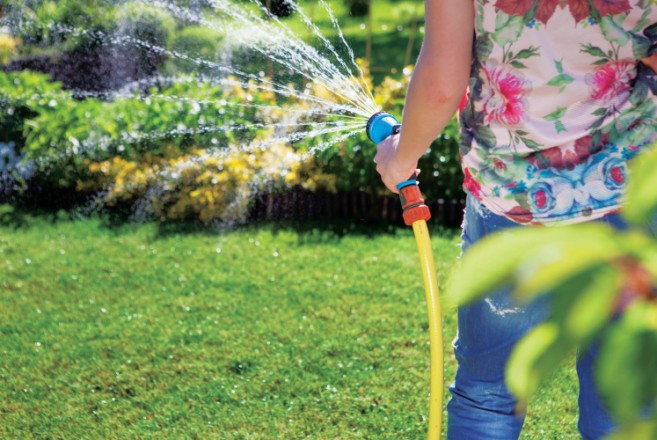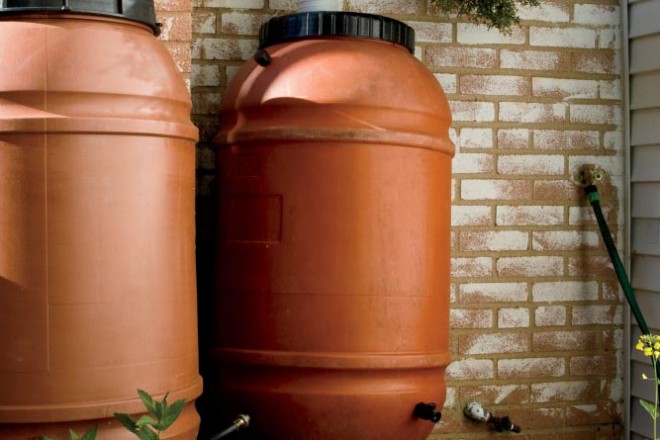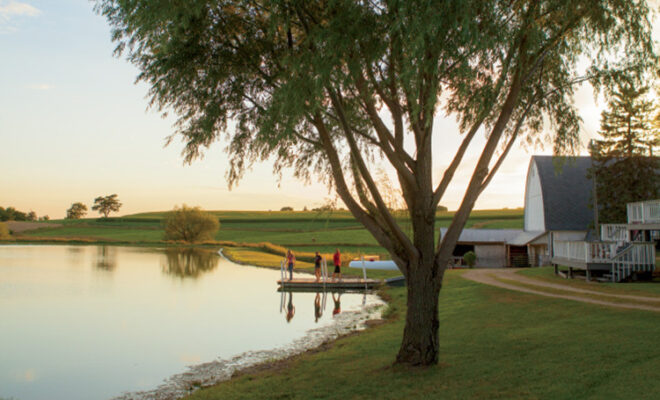
Illinois’ flowing rivers and lakes draw crowds in the summer for fishing, boating and swimming, but year-round, some residents rely heavily on these sources for safe drinking water to keep them hydrated and healthy.
Anyone who fertilizes their lawn or garden plays a role to keep water clean as it flows over yards and pavement into storm drains – and ultimately flows, untreated, into rivers, lakes and other waterways.
What is Nutrient Runoff?
Marcia Willhite, former bureau of water chief at the Illinois Environmental Protection Agency (EPA), says that rain or overwatering can cause nutrients, including nitrogen and phosphorous, to run off into nearby water sources.
“Nitrogen turns into nitrate in the environment. Too much can be toxic to babies if it gets into drinking water,” Willhite says. “If it gets into a lake or river used as a water drinking source, too much means expensive treatment equipment at the water treatment plant.”
She adds that excess phosphorous can result in algae growth, which not only makes for an unpleasing , but some types also produce harmful toxins to people and animals that ingest them.

Keeping drinking water clean is one challenge resulting from runoff, but water quality creates issues for farmers, consumers and Mother Nature alike, according to Paige Buck, Illinois Natural Resources Conservation Service (NRCS) public affairs specialist.
“If the plants aren’t using the nutrients, they get washed into water sources,” Buck says. “The first problem is when the plant needs them, they’re not there. Once the nutrients are in the water, the river doesn’t need them and it messes up the ecosystem. The balance of nature is disturbed, even affecting tiny, microscopic organisms.”
See More
Cities and industries play a role. Studies show discharges from publicly owned treatment works and industrial wastewater treatment plants release 18 million pounds of phosphorus and 87 million pounds of nitrogen annually into streams, rivers and lakes.
Cities, farmers, lawn care professionals, the Illinois EPA, Illinois Department of Agriculture, NRCS, private landowners and other Illinois groups have joined forces to battle runoff issues through the Illinois Nutrient Loss Reduction Strategy. The plan targets ways to improve water quality and offers best management practices for farmers, who need clean, safe water for their livestock and their families. In addition, the plan aims to reduce areas in the Gulf of Mexico where nutrient runoff can cause low oxygen levels that harm animal life.
“Water is a critical resource, and the water cycle is a closed system, so we have to take care of it and keep it in the best possible shape we can,” Buck says.
Urban & Suburban Connection
Nick Menninga of the Downers Grove Sanitary District says the statewide nutrient strategy also impacts towns and cities – in particular, those which operate centralized wastewater treatment facilities.
“The plan calls for the implementation of higher levels of treatment to remove more of the nutrients that are present in municipal wastewater,” he says. “This typically represents additional infrastructure needs and increased costs to operate these facilities.” He adds the strategy encourages municipalities with stormwater management responsibilities to find ways to minimize the discharge of nutrients carried in urban runoff.
You can do your part, too. Steve Neumann, owner of Logic Lawn Care in Evanston, says consumers have the power to control what gets put on their lawns – and ultimately what enters ground and surface water.
“No matter what type of fertilizer is used, consumers should make sure they apply at the appropriate times when the grass is actively growing, usually spring and fall, and at the recommended rate,” Neumann says. “Dispose of it properly, and don’t apply next to bodies of water.”
He also says to avoid overwatering, as most lawns only need 1 inch of water per week, and manage stormwater to make sure it stays on the property rather than running off.
“You can plant a rain garden in areas that get standing water, install a rain barrel, and use permeable materials for things like patios and walkways,” Neumann says.

He also suggests adopting a natural lawn care program that promotes organic matter in the soil. This helps with water absorption. Mowing your lawn when grass is high can help create a thicker turf, which naturally manages nutrient runoff because the soil becomes like a sponge, Neumann says.
The city of Bloomington also released some household tips for keeping water clean, which included directing downspouts away from paved surfaces; not raking or sweeping leaves, grass or soil into the streets; avoiding the use of fertilizer before storms; washing your car on a lawn or at a commercial car wash; and not mowing grass up to the water if you live near a waterway.
“This is an environmental issue that consumers have a real impact on,” Neumann says. “By paying attention to and limiting the amount of nutrient runoff, we’re helping to maintain the health and balance of our rivers, lakes and drinking water.”





I want to make sure that my water is protected. It makes sense that I would want to look into water treatments! I’ll make sure that my city is doing it’s part, too. http://www.wellservicetampabay.com/water-well-drilling.html
I had no idea that mowing your lawn when the grass is tall helps promote organic matter which absorbs water better. The more water that is absorbed, the less water you’ll need to use overall. It may be a good idea to create a schedule to remind you when to mow so you don’t forget.